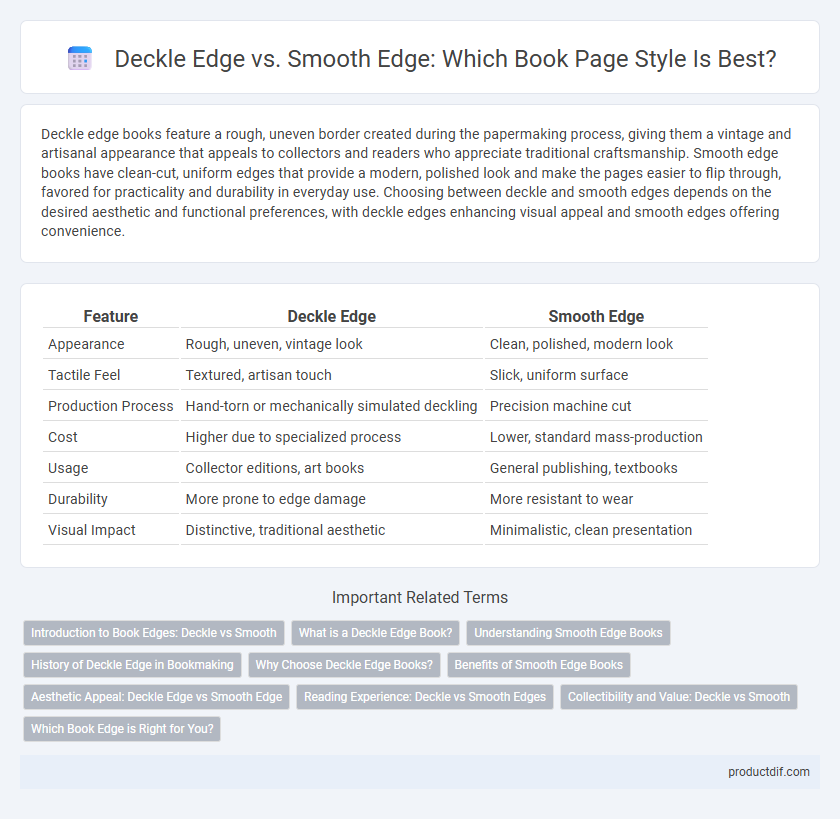Deckle edge books feature a rough, uneven border created during the papermaking process, giving them a vintage and artisanal appearance that appeals to collectors and readers who appreciate traditional craftsmanship. Smooth edge books have clean-cut, uniform edges that provide a modern, polished look and make the pages easier to flip through, favored for practicality and durability in everyday use. Choosing between deckle and smooth edges depends on the desired aesthetic and functional preferences, with deckle edges enhancing visual appeal and smooth edges offering convenience.
Table of Comparison
| Feature | Deckle Edge | Smooth Edge |
|---|---|---|
| Appearance | Rough, uneven, vintage look | Clean, polished, modern look |
| Tactile Feel | Textured, artisan touch | Slick, uniform surface |
| Production Process | Hand-torn or mechanically simulated deckling | Precision machine cut |
| Cost | Higher due to specialized process | Lower, standard mass-production |
| Usage | Collector editions, art books | General publishing, textbooks |
| Durability | More prone to edge damage | More resistant to wear |
| Visual Impact | Distinctive, traditional aesthetic | Minimalistic, clean presentation |
Introduction to Book Edges: Deckle vs Smooth
Deckle edges feature intentionally uneven or rough paper cuts, creating a vintage, handcrafted appearance, popular in limited editions and art books. Smooth edges are precisely cut or trimmed, giving a clean, polished look often found in mass-market publications for durability and uniformity. Choosing between deckle and smooth edges affects the book's aesthetic appeal and perceived value.
What is a Deckle Edge Book?
A deckle edge book features pages with intentionally rough, untrimmed edges that mimic the natural texture of handmade paper, enhancing its vintage and artisanal aesthetic. This design choice originated from traditional papermaking processes where the deckle, a wooden frame, shaped the paper pulp, leaving uneven edges. Deckle edges are often prized in limited editions and fine press books for their unique tactile appeal and visual distinction from smooth edge books.
Understanding Smooth Edge Books
Smooth edge books feature clean, uniform pages that are precisely trimmed, enhancing durability and providing a sleek, modern appearance. This edge style prevents dust accumulation and offers a consistent tactile experience, making it ideal for high-quality prints, textbooks, and professional publications. Readers often prefer smooth edge books for their ease of handling and polished finish, which complements both fiction and non-fiction genres.
History of Deckle Edge in Bookmaking
Deckle edges originated from traditional papermaking processes where handmade paper retained rough, uneven borders due to the wooden frames called deckles. These edges became associated with antique and artisanal books, symbolizing craftsmanship and originality in early book production. Modern publishers sometimes replicate deckle edges to evoke a vintage aesthetic and emphasize the book's artisanal quality.
Why Choose Deckle Edge Books?
Deckle edge books offer a unique tactile experience and an aesthetic appeal that mimics traditional hand-crafted paper, making them highly sought after by collectors and enthusiasts. The irregular, feathered edges create a vintage, artisanal look that enhances the perceived value and authenticity of the book. Choosing deckle edge books supports the preservation of classic bookmaking techniques and adds a distinctive character to any collection.
Benefits of Smooth Edge Books
Smooth edge books offer a polished and professional appearance, enhancing their durability and resistance to wear over time. Their clean-cut edges prevent pages from fraying or accumulating dust, maintaining a pristine look for extended use. This type of edging also facilitates easier stacking and storage, making smooth edge books ideal for libraries and collectors prioritizing aesthetic preservation.
Aesthetic Appeal: Deckle Edge vs Smooth Edge
Deckle edge pages exhibit a textured, uneven border that imparts a vintage, artisanal charm highly valued in limited edition books and fine press publications. Smooth edge pages offer a clean, precise, and modern appearance preferred for contemporary designs and mass-market printings. Collectors and bibliophiles often associate deckle edges with luxury and uniqueness, while smooth edges convey simplicity and uniformity.
Reading Experience: Deckle vs Smooth Edges
Deckle edges create a textured, vintage feel that can enhance the tactile reading experience, appealing to readers who appreciate traditional book aesthetics. Smooth edges provide a clean, modern look and facilitate easier page turning, which benefits quick readers and those seeking a more streamlined design. Choosing between deckle and smooth edges ultimately depends on whether the reader prioritizes aesthetic charm or functional convenience.
Collectibility and Value: Deckle vs Smooth
Deckle edge books, characterized by their rough, untrimmed edges, often appeal to collectors due to their vintage authenticity and perceived rarity, which can enhance their value. In contrast, smooth edge books, with their clean, uniform appearance, are typically associated with modern editions and may attract buyers seeking a polished, contemporary aesthetic. Collectibility and value largely depend on the book's edition, condition, and market demand, but deckle edges frequently signify special releases or early prints, thereby increasing their desirability among bibliophiles.
Which Book Edge is Right for You?
Deckle edge books feature a rough, uneven finish that evokes a vintage and artisanal feel, ideal for collectors and readers who appreciate a classic aesthetic. Smooth edge books provide a clean, polished look that enhances durability and is often preferred for modern, professional publications. Choosing the right book edge depends on your preference for style versus practicality, with deckle edges offering charm and uniqueness, while smooth edges ensure longevity and ease of shelving.
Deckle Edge vs Smooth Edge Infographic

 productdif.com
productdif.com